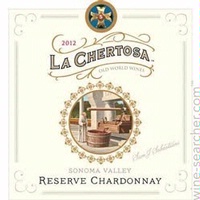SONOMA, Calif. — Chances are you’ve never seen nor tasted a wine from La Chertosa, one of the new kids on the block. Its first release was 2009 and the wines are sold, for the most part, in restaurants and small wine shops in and around the village of Sonoma and a few fine wine shops and restaurants scattered throughout Californi. It also can be found in small quantities in Nebraska and Colorado, or purchased online.
Should you find yourself exploring California wine country and stumble across a bottle of La Chertosa, what you will experience is a California wine made with Old World sensibilities. The La Chertosa wines are not made so much to dazzle as they are to charm.
 Well balanced and beautifully structured, they are made to be enjoyed with food, as well as improve with age. You may wonder who would think of such a thing.
Well balanced and beautifully structured, they are made to be enjoyed with food, as well as improve with age. You may wonder who would think of such a thing.
Chances are you’ve heard of the proprietor, 75-year-old Sam Sebastiani, who now splits his time between his comfortable home overlooking Sonoma and a cattle ranch in Nebraska.
Even if you don’t know much about Sam, you’ve likely heard of Sebastiani, the historic winery that sits on the outskirts of Sonoma. And if all you know about Sebastiani is that the theatre on the Sonoma square is the Sebastiani Theatre, at least you know the Sebastiani family once played a prominent role in the everyday lives of Sonoma residents.
Sam’s grandfather, Samuele, settled in Sonoma in 1893. He came to this country from Italy, having learned to make wine from the monks at a 14th century monsastery, La Chertosa di Farneta, near Lucca.
In its heyday, when Sam was at the helm, the Sebastiani winery produced millions of cases of wine each vintage.
“Back in the day we felt we had to be represented in every chain store in America,” he remembers. “It’s a different way of life. We were always chasing after it.”
The Sebastiani winery was sold some years ago and is now owned by Foley Family Vineyards. Sam went on to run the nearby Viansa Winery with wife Robin, but has since sold off that venture as well.
His pace now is significantly more modest, with production of La Chertosa hovering around 1000 cases per year. He prefers to make the wines he likes, and that means adhering to an Old World style that seems to be coming into vogue once again as winemakers dial back the volume a bit on ripeness and the level of alcohol that comes with that style.
“Old World wines are what we do now,” said Sam. “We’re not trying to make (fruit) bombs.”
Sebastiani sources grapes from Amador County as well as Sonoma and is particularly fond of red Tuscan series soils, which Sam simply refers to as “red soils.”
“Everything we do is grown in red soil,” he said. “We’re staking our flavor profile on the softness and roundness it gives us.”
Robin Sebastiani, an avid cook who is fond of game dishes, chimed in: “There is a harmony of flavors. It’s like a symphony.”
I had the pleasure of visiting Sam and Robin on a recent trip to Sonoma and tasted the four basic wines in the La Chertosa portfolio: a 2014 Chardonnay (91 points), 2014 Reserve Sangiovese (93 points), 2013 Reserve Zinfandel (92 points) and a 2014 Reserve Barbera (90 points). The Chardonnay and Sangiovese were made from grapes grown in Sonoma Valley and the Reserve Zinfandel and Reserve Barbera from grapes grown in Amador County.
Restraint was a common thread through all four wines. Sebastiani, who is the winemaker as well, uses a mixture of old and new oak barrels to age the La Chertosa wines. All show the wood influence without the sometimes overwhelming characteristics that accompany wines made using 100 percent new oak.
The chardonnay was a delight made in a style I find appealing. It was creamy and smooth without being heavy, and the note of lemon crème to me is a signature aspect of high-quality chardonnay.
The reds were attractive in the same sort of way. Each offered exceptionally fruit purity and definition without crossing the line into fruit jam. The Sangiovese was perhaps my favorite because of its tightness and the tension between acidity and fruit.
The zin was low in alcohol (14.5 percent) compared to most modern zins, but it didn’t lack for bright brambly fruit aromas of wild blackberry and blueberry. Ditto the barbera, which delivered enticing wild berry aromas without sacrificing the acid tension that makes for an outstanding food wine.
La Chertosa represents an Old World style that is suddenly new again, and a legendary winemaker who is remarkably comfortable as the new kid on the block.
Follow Robert on Twitter at @wineguru. To find out more about Robert Whitley and read features by other Creators Syndicate writers and cartoonists, visit the Creators Syndicate website at www.creators.com.
8
